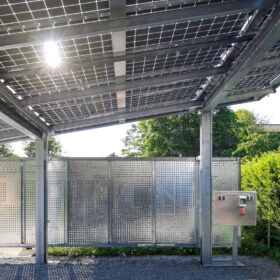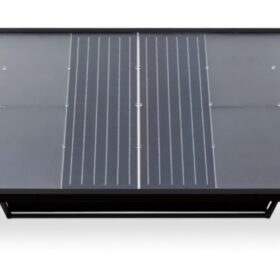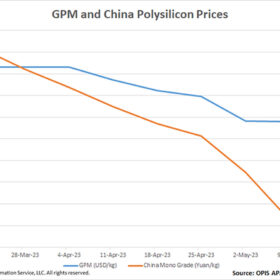Madrid to generate green hydrogen using recycled water, PV, biogas
Madrid will open Spain’s first plant to produce green hydrogen from recycled water in 2024. The facility, situated at a water treatment plant, will use electrolysis to simultaneously extract oxygen and purify water.
Biofuels vs. solar electricity for urban mobility
Solar electricity will have to compete with biofuels in the urban mobility landscape. Biofuels, however, have a very low energy productivity per hectare, as well as high requirements for fertilizers, pesticides, and water.
Solar gazebo provides up to 4.3 kW of backyard generating capacity
Arka Energy’s new outdoor gazebo provides 2.4 kW to 4.3 kW of residential solar power via monocrystalline PERC solar tiles.
New solar panels produce water from humidity
US-based manufacturer Source Global has introduced a solar module technology that can produce drinking water from as little as 10% humidity in the air. The company says that its optimized technology can produce water in a range of conditions.
NASA makes unusual discovery while testing perovskite solar cells in space
NASA has discovered that perovskite solar cells tested in space exhibit less degradation than reference devices tested on Earth. The agency acknowledged that it is uncertain about the specific factors in the space environment that contributed to the superior performance of the perovskite absorber film.
Public-private partnerships: The path to sustainable transportation in India
By bringing together the private sector’s expertise and the public sector’s policy support, public-private partnerships can support the development of new technologies and solutions to improve the performance, efficiency, and affordability of electric vehicles (EVs).
Falling wafer prices continue to make headway for downstream prices
In a new weekly update for pv magazine, OPIS, a Dow Jones company, provides a quick look at the main price trends in the global PV industry.
Qcells builds pilot line for perovskite-silicon tandem PV cells in South Korea
Qcells says it is building a pilot line for perovskite-silicon tandem solar cells that will start operations later this year in South Korea. It is working closely with its team in Germany, where it has already established another pilot line for tandem cells.
Avoiding PV buyer’s remorse
New entrants to solar equipment procurement may be surprised to encounter constantly amended contract terms, index-linked price rises, and near-worthless defect warranties, but they reflect recent supply chain troubles. Clean Energy Associates’ Martin Deak offers a buyers guide.
Polysilicon prices preserve downward trend, weighed down by supply factors
In a new weekly update for pv magazine, OPIS, a Dow Jones company, provides a quick look at the main price trends in the global PV industry.















